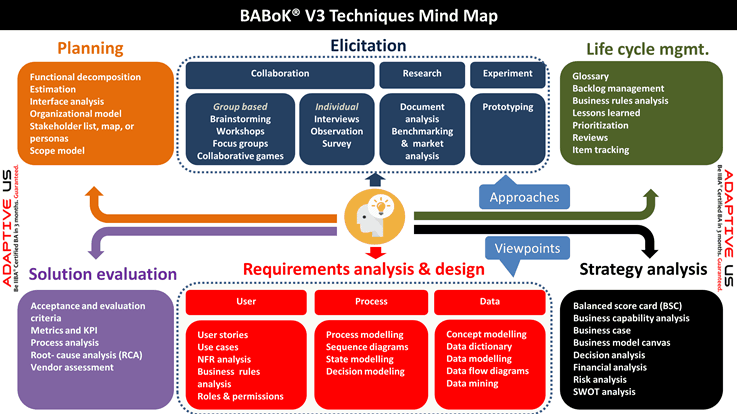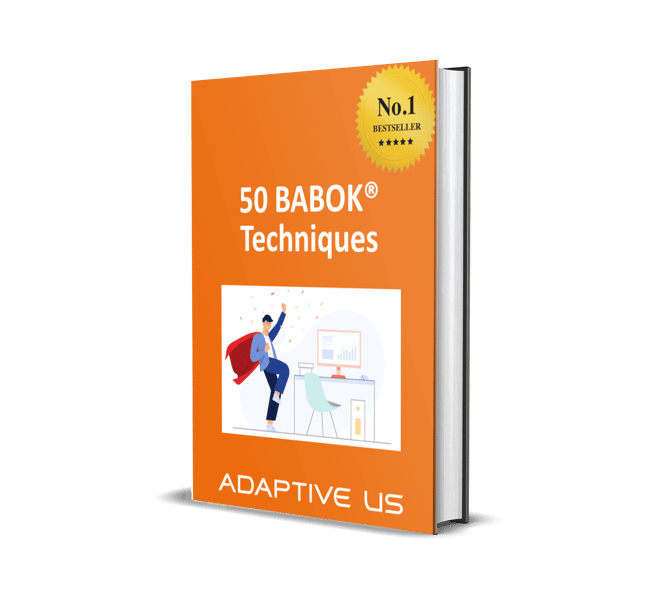BABoK v3 techniques are a lot. There are not just 10, 20, or 30 techniques but 50 techniques, to be precise and that's not a small number!
The human mind can remember 5 to 7 elements at a time and anything more than that is hard to remember.

Then, how can one remember 50 techniques?
"Is it really possible to have a BABoK Techniques Mindmap?"
Many of you may wonder.
So here's the Ultimate BABoK techniques mindmap which could save you 40 hours of your International Institute of Business Analysis (IIBA) exam preparation!

I know many of my good BA friends would vehemently disagree with this output.
Relationships between tasks and techniques are many to many.
A task in Business Analysis Body of Knowledge (BABoK v3) can use many techniques.
Same way, a technique can be used for many tasks.
So how can we place a technique in a single knowledge area?
#1 Why should we group the BABoK techniques?
Since there are 50 techniques in BABoK v3, which is a very high number, any practical way to organize the same can be quite beneficial for business analysts.
It is also quite beneficial to note that when we organize techniques into groups, we can discover common characteristics for many similar techniques.
It is indeed fairly practical to divide elicitation techniques to the group based and individual-based elicitation techniques.
Common characteristics of all group-based elicitation techniques are that:
-
It would have a facilitator, as a group activity is more effective with a facilitator
-
It's difficult to schedule
-
It's good to obtain consensus, and
-
Interpersonal issues and conflicts are quite common in these techniques
There would also be commonalities in the strengths and weaknesses of all group-based elicitation techniques and individual-based elicitation techniques
Similarly, all techniques in Static and Dynamic sub-groups for Requirements analysis design definition (RADD) will have common properties.
#2 What does the BABoK V3 Techniques Mind-map try to achieve?
This BABoK V3 Techniques Mind-map tries to explain the relationship between techniques and BABoK knowledge areas. I would request all my BA friends to be open to explore this mind-map. What we attempted to do was to align techniques to knowledge areas where it contributes the most. This does not imply that the techniques do not contribute to other knowledge areas. Now, a word of caution.
#3 A caution
Before we end, here's a word of caution - Remember tasks and techniques are many to many.
Learn to prepare the SMART WAY, not the HARD WAY!
You can access much more useful business analysis content on our BA learning portal, SuXeed.
Please provide your suggestions to CS@AdaptiveUS.com to make this mind-map even better for all business analysts.
About me
I am a professional BA, business analysis trainer, coach, and author.
If you like my posts please like/share/comment and spread the word in your network.
Would love to connect with fellow professionals.
You can also reach me at LN@AdaptiveUS.com
About Adaptive US (Think BA. Think Adaptive.)
Adaptive US provides CBAP, CCBA, ECBA, AAC, CBDA and CCA business analysis certification training online and consulting needs for Individual or Corporate either online or offline. Adaptive US is an endorsed education provider of IIBA.
For more updates on courses & tips follow us on
Facebook | Twitter | LinkedIn | Google+
No Comments Yet
Let us know what you think